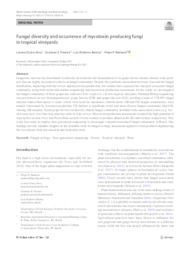Fungal diversity and occurrence of mycotoxin producing fungi in tropical vineyards.
Fungal diversity and occurrence of mycotoxin producing fungi in tropical vineyards.
Author(s): SILVA, L. D.; PEREIRA, G. E.; BATISTA, L. R.; MATTEOLI, F. P.
Summary: Grapevine cultivars are distributed worldwide, nevertheless the fermentation of its grape berries renders distinct wine products that are highly associated to the local fungal community. Despite the symbiotic association between wine and the fungal metabolism, impacting both the terroir and mycotoxin production, few studies have explored the vineyard ecosystem fungal community using both molecular marker sequencing and mycotoxin production assessment. In this study, we investigated the fungal community of three grapevine cultivars (Vitis vinifera L.) in two tropical vineyards. Illumina MiSeq sequencing was performed on two biocompartments: grape berries (GB) and grapevine soil (GS); yielding a total of 578,495 fungal internal transcribed spacer 1 reads, which were used for taxonomic classification. GB and GS fungal communities were mainly constituted by Ascomycota phylum. GS harbors a significant richer and more diverse fungal community than GB. Among GB samples, Syrah grape berries exclusively shared fungal community included wine-associated yeasts (e.g. Saccharomycopsis vini) that may play key roles in wine terroir. Mycotoxin production assessment revealed the high potential of Aspergillus section Flavi and Penicillium section Citrina isolates to produce aflatoxin B1-B2 and citrinin, respectively. This is the first study to employ next-generation sequencing to investigate vineyard associated fungal community in Brazil. Our findings provide valuable insights on the available tools for fungal ecology assessment applied to food products emphasizing the coexistence between classical and molecular tools.
Publication year: 2021
Types of publication: Journal article
Unit: Embrapa Grape & Wine
Keywords: Fungal ecology, Next-generation sequencing, Terroir, Tropical vineyard, Wine
Observation
Some of Embrapa's publications are published as ePub files. To read them, use or download one of the following free software options to your computer or mobile device. Android: Google Play Books; IOS: iBooks; Windows and Linux: Calibre.
Access other publications
Access the Agricultural Research Database (BDPA) to consult Embrapa's full library collection and records.
Visit Embrapa Bookstore to purchase books and other publications sold by Embrapa.

